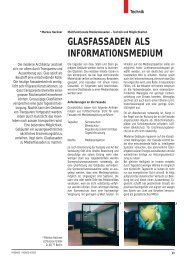British Antarctic Survey - netzentwurf.de
British Antarctic Survey - netzentwurf.de
British Antarctic Survey - netzentwurf.de
Create successful ePaper yourself
Turn your PDF publications into a flip-book with our unique Google optimized e-Paper software.
The Site - Background Brief<br />
The Location<br />
Halley Research Station is located on the Brunt Ice Shelf, Coats Land <strong>Antarctic</strong>a. It lies within <strong>British</strong><br />
<strong>Antarctic</strong> Territory.<br />
There have been five Halley Research Stations on the Brunt Ice Shelf since 1956.The annual snow<br />
build-up and the movement of the ice shelf towards the sea necessitate the periodic rebuilding of the<br />
station. A number of <strong>de</strong>sign options from simple huts to buildings on skis have been employed over<br />
this period. Scientific knowledge about the dynamic properties of snow and ice has advanced<br />
consi<strong>de</strong>rably since 1956 and <strong>de</strong>sign teams will have access to this expertise during briefing consultation<br />
at Stage Two of the competition.<br />
The present Halley V Research Station is a series of science and accommodation platforms raised<br />
above the ice surface on jackable legs. There are also two moveable structures on giant skis. The<br />
station is the most successful so far in terms of its longevity, use of technology and living experience.<br />
However, annual re-supply and maintenance are major challenges requiring significant logistics and<br />
human resources, because specialist teams are required to visit the station each austral summer to<br />
clear accumulated snow and raise the structures.<br />
Site Conditions and Special Consi<strong>de</strong>rations<br />
The Brunt Ice Shelf is 150 m thick, flows at a rate of 0.4 km per year northwest from Coats Land<br />
towards the sea where, at irregular intervals, it calves off as vast icebergs. Scientists predict a major<br />
calving event around 2010, after which the current flow rate of approximately 0.4 km per year is<br />
expected to increase to 1-1.5 km per year. There is a growing risk that the current research station<br />
could be lost due to a calving event in the next <strong>de</strong>ca<strong>de</strong>. It is necessary therefore to <strong>de</strong>sign and build a<br />
replacement station for initial operation in 2008/09.<br />
The movement of the ice shelf towards the sea, the annual 1.5 m build-up of snowfall, and significant<br />
snowdrift are challenging conditions for buildings in this location. To cope with the natural forces of<br />
this extreme environment a successful solution will require innovation and creativity in <strong>de</strong>sign,<br />
engineering and technology.<br />
Environmental Conditions<br />
Snow and ice accumulation is high on the Brunt Ice Shelf ranging on average from 1-1.5m in <strong>de</strong>pth per<br />
year. Snow falls on around 175 days each year. Rain has never been reported but freezing drizzle may<br />
occur. The dynamic forces within the ice are multi-directional.<br />
An ice shelf is the floating extension of the groun<strong>de</strong>d ice sheet. It is composed of freshwater ice<br />
that originally fell as snow, either in situ or inland and brought to the ice shelf by glaciers. These are<br />
largely consi<strong>de</strong>red as permanent features.<br />
Sea ice is frozen seawater that forms around the continent in the autumn, as a floating layer only a<br />
few metres thick. Most of it melts during the summer.<br />
Temperatures range from -55ºC in the <strong>Antarctic</strong> winter and +4.5ºC during the summer.<br />
However, average mid-summer temperatures are around -5ºC and average winter temperatures are<br />
around -30ºC.<br />
Wind conditions vary from periods of absolute calm to days of continuous storm.The extreme mean<br />
hourly wind speed is approximately 30 m/sec with extreme gust speeds up to 40 m/sec.The mean wind<br />
speed is 7 m/sec.The wind causes drifting snow on about 180 days each year, which becomes general<br />
blowing snow on about 175 days each year. Gales occur on average about 40 days per year.<br />
Light conditions. There is 24 hr daylight during the <strong>Antarctic</strong> summer with sunshine on average for<br />
1445 hours per year (approx 34% of the maximum possible).There is darkness for 55 days in winter<br />
and the sun does not appear above the horizon for 100 days.<br />
3<br />
Supporting Documents









